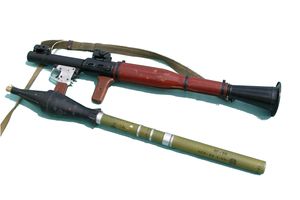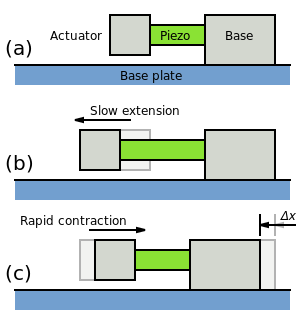كهرباء انضغاطية
الكهرباء الانضغاطية Piezoelectricity هو قدرة بعض المواد (وخصوصا الكريستال، وبعض المواد السيراميكية، بما فيها العظم) على توليد كمون كهربائي استجابة لتطبيق إجهاد ميكانيكي. هذا قد يأخذ شكل لفصل الشحنة الكهربائية عبر البنية البللورية. إذا كانت هذه المواد غير مقصورة الدارة، فإن الشحنة المطبقة ستولد جهد كهربائي في المادة.
تأثير الكهرباء الانضغاطية هو تأثير عكوس، بحيث يتولد إجهاد ميكانيكي في المادة عند إخضاعها لفرق جهد كهربائي.
لهذا الأثر تطبيقات مفيدة مثل إنتاج واستشعار الصوت، وتوليد جهد كهربائي عالي، توليد تردد إلكتروني، الموازين الدقيقة.
الكهرباء الانضغاطية[1] هي electric charge that accumulates in certain solid materials—such as crystals, certain ceramics, and biological matter such as bone, DNA, and various proteins—in response to applied mechanical stress.[2] The word piezoelectricity means electricity resulting from pressure and latent heat. It is derived من يونانية قديمة πιέζω (piézō)، وتعني "to squeeze or press", و ἤλεκτρον (ḗlektron)، وتعني "amber" (an ancient source of electric current).[3][4]
The piezoelectric effect results from the linear electromechanical interaction between the mechanical and electrical states in crystalline materials with no inversion symmetry.[5] The piezoelectric effect is a reversible process: materials exhibiting the piezoelectric effect also exhibit the reverse piezoelectric effect, the internal generation of a mechanical strain resulting from an applied electric field. For example, lead zirconate titanate crystals will generate measurable piezoelectricity when their static structure is deformed by about 0.1% of the original dimension. Conversely, those same crystals will change about 0.1% of their static dimension when an external electric field is applied. The inverse piezoelectric effect is used in the production of ultrasound waves.[6]
French physicists Jacques and Pierre Curie discovered piezoelectricity in 1880.[7] The piezoelectric effect has been exploited in many useful applications, including the production and detection of sound, piezoelectric inkjet printing, generation of high voltage electricity, as a clock generator in electronic devices, in microbalances, to drive an ultrasonic nozzle, and in ultrafine focusing of optical assemblies. It forms the basis for scanning probe microscopes that resolve images at the scale of atoms. It is used in the pickups of some electronically amplified guitars and as triggers in most modern electronic drums.[8][9] The piezoelectric effect also finds everyday uses, such as generating sparks to ignite gas cooking and heating devices, torches, and cigarette lighters.
التاريخ
الاكتشاف والأبحاث المبكرة
The pyroelectric effect, by which a material generates an electric potential in response to a temperature change, was studied by Carl Linnaeus and Franz Aepinus in the mid-18th century. Drawing on this knowledge, both René Just Haüy and Antoine César Becquerel posited a relationship between mechanical stress and electric charge; however, experiments by both proved inconclusive.[10]
أول عرض لأثر الكهرباء الانضغاطية كان في العام 1880 بواسطة الأخوين پيير كوري وپول-جاك كوري.[11] وذلك من خلال عملهما وخبرتهما في الكهرباء الحرارية pyroelectricity (توليد الكهرباء بواسطة التسخين) وعلاقة ذلك بالتركيب البلوري حيث توقعا أن يكون للضغط أيضا تأثير لتوليد الكهرباء. تمكن الأخوان من توقع سلوك البلورات، وعرض الأثر باستخدام بلورات tourmaline, quartz, topaz, cane sugar, وملح روشل (تتراهيدرات طرطرات الصوديوم بوتاسيوم). Quartz and Rochelle salt exhibited the most piezoelectricity.
وقد اُكتشف هذا المفعول عندما وُضعت أثقال فوق بلورات مثل الكوارتز وملح روشيل - الذي هو ليس إلا طرطرات البوتاسيوم والصوديوم - فوُجد أن شحنات كهربائية تتولد على سطحي البلورة، وقد تحقق العالمان كوري في العام التالي من حدوث المفعول المعاكس. ولازال الكوارتز يستخدم حتى اليوم في الهزازات الإلكترونية، وكذلك شأن ملح روشيل الذي يُستخدم حالياً في صنع مكبرات الصوت (الميكروفونات)؛ وذلك لتميُّزه بتوليد الفعل الكهرضغطي بشدة عالية، إلا أن مجال عمله الحراري محدود حتى الدرجة 23 ْم.
The Curies, however, did not predict the converse piezoelectric effect. The converse effect was mathematically deduced from fundamental thermodynamic principles by Gabriel Lippmann in 1881.[12] The Curies immediately confirmed the existence of the converse effect,[13] and went on to obtain quantitative proof of the complete reversibility of electro-elasto-mechanical deformations in piezoelectric crystals.
For the next few decades, piezoelectricity remained something of a laboratory curiosity, though it was a vital tool in the discovery of polonium and radium by Pierre and Marie Curie in 1898. More work was done to explore and define the crystal structures that exhibited piezoelectricity. This culminated in 1910 with the publication of Woldemar Voigt's Lehrbuch der Kristallphysik (Textbook on Crystal Physics),[14] which described the 20 natural crystal classes capable of piezoelectricity, and rigorously defined the piezoelectric constants using tensor analysis.
يشار إلى أنه كي تولِّد بلورة ما مفعولاً كهرضغطياً لابد من أن تخلو بنيتها البلورية من مركز تناظر، وإلى أنه من بين أصناف التناظرات في البلورات، وعددها 32 صنفاً، يبدي عشرون صنفاً منها فقط مفعولاً كهرضغطياً.
إن خضوع بلورة لاتمتلك مركز تناظر للضغط الميكانيكي يسبب انزياح الأيونات في الشبكة البلورية عن مواضعها، الأمر الذي ينجم عنه توليد حقل كهربائي، وتبلغ شدة الحقل الكهربائي في بعض البلورات القيمة (1010 فولط/متر).
الحرب العالمية الأولى
اُستخدم المفعول الكهرضغطي إبان الحرب العالمية الأولى عام 1917 لكشف الغواصات بالأمواج فوق الصوتية، حين قام العالم الفرنسي پول لانگڤان P.Langevin وزملاؤه بصنع محوِّل طاقة transducer مؤلَّفٍ من مصفوفة من شرائح الكوارتز الرقيقة ألصقت بين صفيحتين فولاذيتين بحيث تؤلف المجموعة جملة مهتزة ذات تجاوب resonant عند التواتر 50 كيلو هرتز، واختير الحامل الملائم لها كي تعمل تحت الماء.[15] وبانتهاء الحرب العالمية الأولى خضعت الجملة المهتزة تلك للتعديل بحيث غدت تعمل عند ترددات أعلى بكثير، واستخدمت في أغراض كشف الصدى وأنظمة السونار sonar، أي الرادار الصوتي، الذي يكشف الأجسام تحت الماء كأسراب السمك، ويصوِّر قاع المحيطات بل ويرسم تضاريسها. وقد استخدمت مجاوبات من الكوارتز تعمل عند ترددات تقدر بالميغا هرتز أي 610 هرتز ومضاعفاتها، لتوليد أمواج إذاعية ذات تردد عالي الاستقرار، وهو أمر مرغوب فيه جداً في ميدان البث الإذاعي.
طُوِّرت مواد ووسائل اختبار تعتمد على انتشار الأمواج فوق الصوتية لدراسة خواص السوائل والغازات مثل المرونة واللزوجة، كما استخدمت هذه الأمواج لكشف التشققات أو التشوُّهات في السبائك المعدنية من دون تعريضها للتلف فيما يسمى بالاختبارات اللاإتلافية non- destructive testing التي يرمز لها اختصاراً بـ NDT، ويظهر في الشكل (2) اختبار من هذا القبيل.
The use of piezoelectricity in sonar, and the success of that project, created intense development interest in piezoelectric devices. Over the next few decades, new piezoelectric materials and new applications for those materials were explored and developed.
Piezoelectric devices found homes in many fields. Ceramic phonograph cartridges simplified player design, were cheap and accurate, and made record players cheaper to maintain and easier to build. The development of the ultrasonic transducer allowed for easy measurement of viscosity and elasticity in fluids and solids, resulting in huge advances in materials research. Ultrasonic time-domain reflectometers (which send an ultrasonic pulse through a material and measure reflections from discontinuities) could find flaws inside cast metal and stone objects, improving structural safety.
الحرب العالمية الثانية وما بعدها
During World War II, independent research groups in the United States, Russia, and Japan discovered a new class of synthetic materials, called ferroelectrics, which exhibited piezoelectric constants many times higher than natural materials. This led to intense research to develop barium titanate and later lead zirconate titanate materials with specific properties for particular applications.
One significant example of the use of piezoelectric crystals was developed by Bell Telephone Laboratories. Following World War I, Frederick R. Lack, working in radio telephony in the engineering department, developed the "AT cut" crystal, a crystal that operated through a wide range of temperatures. Lack's crystal did not need the heavy accessories previous crystal used, facilitating its use on aircraft. This development allowed Allied air forces to engage in coordinated mass attacks through the use of aviation radio.
Development of piezoelectric devices and materials in the United States was kept within the companies doing the development, mostly due to the wartime beginnings of the field, and in the interests of securing profitable patents. New materials were the first to be developed—quartz crystals were the first commercially exploited piezoelectric material, but scientists searched for higher-performance materials. Despite the advances in materials and the maturation of manufacturing processes, the United States market did not grow as quickly as Japan's did. Without many new applications, the growth of the United States' piezoelectric industry suffered.
In contrast, Japanese manufacturers shared their information, quickly overcoming technical and manufacturing challenges and creating new markets. In Japan, a temperature stable crystal cut was developed by Issac Koga. Japanese efforts in materials research created piezoceramic materials competitive to the United States materials but free of expensive patent restrictions. Major Japanese piezoelectric developments included new designs of piezoceramic filters for radios and televisions, piezo buzzers and audio transducers that can connect directly to electronic circuits, and the piezoelectric igniter, which generates sparks for small engine ignition systems and gas-grill lighters, by compressing a ceramic disc. Ultrasonic transducers that transmit sound waves through air had existed for quite some time but first saw major commercial use in early television remote controls. These transducers now are mounted on several car models as an echolocation device, helping the driver determine the distance from the car to any objects that may be in its path.
آلية العمل

في بلورة المادة الكهربائية الانضغاطية تكون الشحنات السلبية والموجبة مفصولة، ولكن موزعة بشكل متناظر، بحيث تكون الشبكة البلورية متعادلة كهربائيا بشكل عام. يشكل كل من هذه الأطراف ثنائي أقطاب كهربائي، وعادة تميل ثنائيات الأقطاب القريبة من بعضها البعض إلى أن تكون متسقة في مناطق تدعى "مجالات ڤايس" Weiss domains. تكون هذه المجالات عادة موجهة عشوائيا، ولكن يمكن أن تكون متسقة خلال الاستقطاب (يختلف هذا عن عملية الاستقطاب المغناطيسي)، والذي يتم من خلال تطبيق مجال كهربائي قوي عبر المادة عادة في درجات حرارة مرتفعة.
عند تطبيق جهد ميكانيكي يتشوه التوضع المتناظر للشحنات وهذا يؤدي إلى توليد الجهد الكهربائي عبر المادة. على سبيل المثال إن طبق 2 كيلو نيوتن من القوة على 1 سم3 من الكوارتز يمكن أن تنتج من الجهد 12500 فولت. [16]
Of decisive importance for the piezoelectric effect is the change of polarization P when applying a mechanical stress. This might either be caused by a reconfiguration of the dipole-inducing surrounding or by re-orientation of molecular dipole moments under the influence of the external stress. Piezoelectricity may then manifest in a variation of the polarization strength, its direction or both, with the details depending on: 1. the orientation of P within the crystal; 2. crystal symmetry; and 3. the applied mechanical stress. The change in P appears as a variation of surface charge density upon the crystal faces, i.e. as a variation of the electric field extending between the faces caused by a change in dipole density in the bulk. For example, a 1 cm3 cube of quartz with 2 kN (500 lbf) of correctly applied force can produce a voltage of 12500 V.[17]
Piezoelectric materials also show the opposite effect, called the converse piezoelectric effect, where the application of an electrical field creates mechanical deformation in the crystal.
Mathematical description
Linear piezoelectricity is the combined effect of
- The linear electrical behavior of the material:
- where D is the electric flux density[18][19] (electric displacement), ε is the permittivity (free-body dielectric constant), E is the electric field strength, and , .
- Hooke's law for linear elastic materials:
- where S is the linearized strain, s is compliance under short-circuit conditions, T is stress, and
- ,
- where u is the displacement vector.
These may be combined into so-called coupled equations, of which the strain-charge form is:[20]
where is the piezoelectric tensor and the superscript t stands for its transpose. Due to the symmetry of , .
In matrix form,
where [d] is the matrix for the direct piezoelectric effect and [dt] is the matrix for the converse piezoelectric effect. The superscript E indicates a zero, or constant, electric field; the superscript T indicates a zero, or constant, stress field; and the superscript t stands for transposition of a matrix.
Notice that the third order tensor maps vectors into symmetric matrices. There are no non-trivial rotation-invariant tensors that have this property, which is why there are no isotropic piezoelectric materials.
The strain-charge for a material of the 4mm (C4v) crystal class (such as a poled piezoelectric ceramic such as tetragonal PZT or BaTiO3) as well as the 6mm crystal class may also be written as (ANSI IEEE 176):
where the first equation represents the relationship for the converse piezoelectric effect and the latter for the direct piezoelectric effect.[21]
Although the above equations are the most used form in literature, some comments about the notation are necessary. Generally, D and E are vectors, that is, Cartesian tensors of rank 1; and permittivity ε is a Cartesian tensor of rank 2. Strain and stress are, in principle, also rank-2 tensors. But conventionally, because strain and stress are all symmetric tensors, the subscript of strain and stress can be relabeled in the following fashion: 11 → 1; 22 → 2; 33 → 3; 23 → 4; 13 → 5; 12 → 6. (Different conventions may be used by different authors in literature. For example, some use 12 → 4; 23 → 5; 31 → 6 instead.) That is why S and T appear to have the "vector form" of six components. Consequently, s appears to be a 6-by-6 matrix instead of a rank-3 tensor. Such a relabeled notation is often called Voigt notation. Whether the shear strain components S4, S5, S6 are tensor components or engineering strains is another question. In the equation above, they must be engineering strains for the 6,6 coefficient of the compliance matrix to be written as shown, i.e., 2(sE11 − sE12). Engineering shear strains are double the value of the corresponding tensor shear, such as S6 = 2S12 and so on. This also means that s66 = 1/G12, where G12 is the shear modulus.
In total, there are four piezoelectric coefficients, dij, eij, gij, and hij defined as follows:
where the first set of four terms corresponds to the direct piezoelectric effect and the second set of four terms corresponds to the converse piezoelectric effect. The equality between the direct piezoelectric tensor and the transpose of the converse piezoelectric tensor originates from the Maxwell relations of thermodynamics.[22] For those piezoelectric crystals for which the polarization is of the crystal-field induced type, a formalism has been worked out that allows for the calculation of piezoelectrical coefficients dij from electrostatic lattice constants or higher-order Madelung constants.[23]
صفوف الكريستال

Of the 32 crystal classes, 21 are non-centrosymmetric (not having a centre of symmetry), and of these, 20 exhibit direct piezoelectricity[24] (the 21st is the cubic class 432). Ten of these represent the polar crystal classes,[25] which show a spontaneous polarization without mechanical stress due to a non-vanishing electric dipole moment associated with their unit cell, and which exhibit pyroelectricity. If the dipole moment can be reversed by applying an external electric field, the material is said to be ferroelectric.
- The 10 polar (pyroelectric) crystal classes: 1, 2, m, mm2, 4, 4mm [ك], 3, 3m, 6, 6mm [ك].
- The other 10 piezoelectric crystal classes: 222, 4, 422, 42m, 32, 6, 622, 62m, 23, 43m.
For polar crystals, for which P ≠ 0 holds without applying a mechanical load, the piezoelectric effect manifests itself by changing the magnitude or the direction of P or both.
For the nonpolar but piezoelectric crystals, on the other hand, a polarization P different from zero is only elicited by applying a mechanical load. For them the stress can be imagined to transform the material from a nonpolar crystal class (P = 0) to a polar one,[23] having P ≠ 0.
المواد
تكون البلورات طبيعياً
العظام
غيرها من المواد الطبيعية
البلورات الاصطناعية
السيراميك
Ceramics with randomly oriented grains must be ferroelectric to exhibit piezoelectricity.[26] The occurrence of abnormal grain growth (AGG) in sintered polycrystalline piezoelectric ceramics has detrimental effects on the piezoelectric performance in such systems and should be avoided, as the microstructure in piezoceramics exhibiting AGG tends to consist of few abnormally large elongated grains in a matrix of randomly oriented finer grains. Macroscopic piezoelectricity is possible in textured polycrystalline non-ferroelectric piezoelectric materials, such as AlN and ZnO. The families of ceramics with perovskite, tungsten-bronze, and related structures exhibit piezoelectricity:
- Lead zirconate titanate (Pb[Zr
xTi
1-x]O
3 with 0 ≤ x ≤ 1) – more commonly known as PZT, the most common piezoelectric ceramic in use today. - Potassium niobate (KNbO3)[27]
- Sodium tungstate (Na2WO3)
- Ba2NaNb5O5
- Pb2KNb5O15
- Zinc oxide (ZnO) – Wurtzite structure. While single crystals of ZnO are piezoelectric and pyroelectric, polycrystalline (ceramic) ZnO with randomly oriented grains exhibits neither piezoelectric nor pyroelectric effect. Not being ferroelectric, polycrystalline ZnO cannot be poled like barium titanate or PZT. Ceramics and polycrystalline thin films of ZnO may exhibit macroscopic piezoelectricity and pyroelectricity only if they are textured (grains are preferentially oriented), such that the piezoelectric and pyroelectric responses of all individual grains do not cancel. This is readily accomplished in polycrystalline thin films.[21]
Lead-free piezoceramics
البوليمرات
الاستخدامات
الجهد العالي ومصادر الطاقة
وقد استخدُمت محوِّلات طاقة بأشكال هندسية مختلفة (كرات، أسطوانات) وبحجوم متفاوتة من مواد سيراميكية مصنَّعة لتوليد أنظمة سونار عالية الطاقة لأغراض مختلفة تجارية وعسكرية وطبية. كما انتشرت الولاعات الكهرضغطية التي تشعل الغاز عن طريق شرارة تنبجس بين وجهي قرص سيراميكي من مواد كهرضغطية عندما يتعرض للإجهاد الميكانيكي. وصنعت مكبرات صوت (مكروفونات) حساسة صغيرة، لا تستهلك طاقة تُذكر، وتعمل عند جهود كهربائية ضعيفة، كما صنعت أقراص سيراميكية محصورة بين قرصين من معدنين رقيقين لتعمل عمل مكبر صوت ولتصدر نغمات موسيقية استجابة لإشارات تردها من دارات منطقية.
كما استخدمت المواد الكهرضغطية لصنع مرشِّحات للترددات العالية في التجهيزات التي تعمل بالأمواج فوق الصوتية السطحية surface acoustic waves التي يرمز لها اختصاراً بـ SAW. كما استخدمت البلورات الكهرضغطية لقياس الظواهر الميكانيكية العابرة transient لسرعة استجابتها التي تقارب الميكروثانية، أي 10-6 ثانية. ومن بين هذه الظواهر دراسة حوادث احتراق وقود الصواريخ والصدم والتسارعات والاهتزازات الميكانيكية السريعة.
إن الدراسة الرياضية للمفعول الكهرضغطي معقدة، وخلاصتها أنه إذا تألفت مكثفة من مادة كهرضغطية ثابت نفوذيتها ε بحيث يكون السطح المشترك بين لبوسيها S وإذا طُبِّق عليها جهد كهربائي U فإن الشحنة التي تتوضَّع عليها Q، تعطى بدلالة أبعاد المكثفة والقوة F المطبقة عليها بالعلاقة:
حيث KQ معامل الشحنة الكهرضغطية ويقدر بالكولون/نيوتن وقيمته بالنسبة للكوارتز 10-12 كولون/نيوتن، وe الشحنة العنصرية.[28]
المجسات
 مقالة مفصلة: الاستشعار الكهرضغطي
مقالة مفصلة: الاستشعار الكهرضغطي
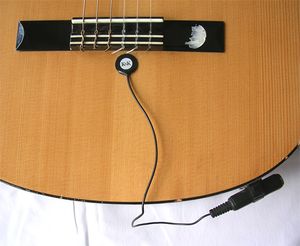
المحركات
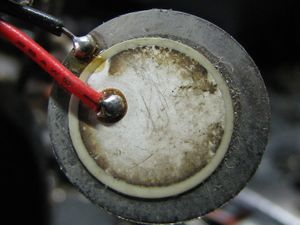
Types of piezoelectric motor include:
- The Ultrasonic motor used for auto-focus in reflex cameras
- Inchworm motors for linear motion
- Rectangular four-quadrant motors with high power density (2.5 W/cm3) and speed ranging from 10 nm/s to 800 mm/s.
- Stepping piezo motor, using stick-slip effect.
Aside from the stepping stick-slip motor, all these motors work on the same principle. Driven by dual orthogonal vibration modes with a phase difference of 90°, the contact point between two surfaces vibrates in an elliptical path, producing a frictional force between the surfaces. Usually, one surface is fixed, causing the other to move. In most piezoelectric motors, the piezoelectric crystal is excited by a sine wave signal at the resonant frequency of the motor. Using the resonance effect, a much lower voltage can be used to produce a high vibration amplitude.
A stick-slip motor works using the inertia of a mass and the friction of a clamp. Such motors can be very small. Some are used for camera sensor displacement, thus allowing an anti-shake function.
معيار التردد
The piezoelectrical properties of quartz are useful as a standard of frequency.
- Quartz clocks employ a crystal oscillator made from a quartz crystal that uses a combination of both direct and converse piezoelectricity to generate a regularly timed series of electrical pulses that is used to mark time. The quartz crystal (like any elastic material) has a precisely defined natural frequency (caused by its shape and size) at which it prefers to oscillate, and this is used to stabilize the frequency of a periodic voltage applied to the crystal.
- The same principle is used in some radio transmitters and receivers, and in computers where it creates a clock pulse. Both of these usually use a frequency multiplier to reach gigahertz ranges.
محركات كهرضغطية
 مقالة مفصلة: محركات كهرضغطية
مقالة مفصلة: محركات كهرضغطية
Types of piezoelectric motor include:
- The Ultrasonic motor used for auto-focus in reflex cameras
- Inchworm motors for linear motion
- Rectangular four-quadrant motors with high power density (2.5 W/cm3) and speed ranging from 10 nm/s to 800 mm/s.
- Stepping piezo motor, using stick-slip effect.
Aside from the stepping stick-slip motor, all these motors work on the same principle. Driven by dual orthogonal vibration modes with a phase difference of 90°, the contact point between two surfaces vibrates in an elliptical path, producing a frictional force between the surfaces. Usually, one surface is fixed, causing the other to move. In most piezoelectric motors, the piezoelectric crystal is excited by a sine wave signal at the resonant frequency of the motor. Using the resonance effect, a much lower voltage can be used to produce a high vibration amplitude.
A stick-slip motor works using the inertia of a mass and the friction of a clamp. Such motors can be very small. Some are used for camera sensor displacement, thus allowing an anti-shake function.
الحد من الاهتزازات والضوضاء
Different teams of researchers have been investigating ways to reduce vibrations in materials by attaching piezo elements to the material. When the material is bent by a vibration in one direction, the vibration-reduction system responds to the bend and sends electric power to the piezo element to bend in the other direction. Future applications of this technology are expected in cars and houses to reduce noise. Further applications to flexible structures, such as shells and plates, have also been studied for nearly three decades.
In a demonstration at the Material Vision Fair in Frankfurt in November 2005, a team from TU Darmstadt in Germany showed several panels that were hit with a rubber mallet, and the panel with the piezo element immediately stopped swinging.
Piezoelectric ceramic fiber technology is being used as an electronic damping system on some HEAD tennis rackets.[30]
All piezo transducers have a fundamental resonant frequency and many harmonic frequencies. Piezo driven Drop-On-Demand fluid systems are sensitive to extra vibrations in the piezo structure that must be reduced or eliminated. One inkjet company, Howtek, Inc solved this problem by replacing glass(rigid) inkjet nozzles with Tefzel (soft) inkjet nozzles. This novel idea popularized single nozzle inkjets and they are now used in 3D Inkjet printers that run for years if kept clean inside and not overheated (Tefzel creeps under pressure at very high temperatures)
علاج العقم
In people with previous total fertilization failure, piezoelectric activation of oocytes together with intracytoplasmic sperm injection (ICSI) seems to improve fertilization outcomes.[31]
الجراحة
Piezosurgery[32] is a minimally invasive technique that aims to cut a target tissue with little damage to neighboring tissues. For example, Hoigne et al.[33] uses frequencies in the range 25–29 kHz, causing microvibrations of 60–210 μm. It has the ability to cut mineralized tissue without cutting neurovascular tissue and other soft tissue, thereby maintaining a blood-free operating area, better visibility and greater precision.[34]
تطبيقات ممكنة
In 2015, Cambridge University researchers working in conjunction with researchers from the National Physical Laboratory and Cambridge-based dielectric antenna company Antenova Ltd, using thin films of piezoelectric materials found that at a certain frequency, these materials become not only efficient resonators, but efficient radiators as well, meaning that they can potentially be used as antennas. The researchers found that by subjecting the piezoelectric thin films to an asymmetric excitation, the symmetry of the system is similarly broken, resulting in a corresponding symmetry breaking of the electric field, and the generation of electromagnetic radiation.[35][36]
Several attempts at the macro-scale application of the piezoelectric technology have emerged[37][38] to harvest kinetic energy from walking pedestrians.
In this case, locating high traffic areas is critical for optimization of the energy harvesting efficiency, as well as the orientation of the tile pavement significantly affects the total amount of the harvested energy.[39] A density flow evaluation is recommended to qualitatively evaluate the piezoelectric power harvesting potential of the considered area based on the number of pedestrian crossings per unit time.[40] In X. Li's study, the potential application of a commercial piezoelectric energy harvester in a central hub building at Macquarie University in Sydney, Australia is examined and discussed. Optimization of the piezoelectric tile deployment is presented according to the frequency of pedestrian mobility and a model is developed where 3.1% of the total floor area with the highest pedestrian mobility is paved with piezoelectric tiles. The modelling results indicate that the total annual energy harvesting potential for the proposed optimized tile pavement model is estimated at 1.1 MW h/year, which would be sufficient to meet close to 0.5% of the annual energy needs of the building.[40] In Israel, there is a company which has installed piezoelectric materials under a busy highway. The energy generated is enough to power street lights, billboards, and signs.[بحاجة لمصدر]
Tire company Goodyear has plans to develop an electricity generating tire which has piezoelectric material lined inside it. As the tire moves, it deforms and thus electricity is generated.[41]
The efficiency of a hybrid photovoltaic cell that contains piezoelectric materials can be increased simply by placing it near a source of ambient noise or vibration. The effect was demonstrated with organic cells using zinc oxide nanotubes. The electricity generated by the piezoelectric effect itself is a negligible percentage of the overall output. Sound levels as low as 75 decibels improved efficiency by up to 50%. Efficiency peaked at 10 kHz, the resonant frequency of the nanotubes. The electrical field set up by the vibrating nanotubes interacts with electrons migrating from the organic polymer layer. This process decreases the likelihood of recombination, in which electrons are energized but settle back into a hole instead of migrating to the electron-accepting ZnO layer.[42][43]
انظر أيضاً
- Charge amplifier
- Electret
- مكون إلكتروني
- Electrostriction
- Flexoelectricity
- Magnetostriction
- Photoelectric effect
- Piezoelectric speaker
- Piezoluminescence
- Piezomagnetism
- Piezoresistive effect
- Piezosurgical
- Quartz crystal microbalance
- Sonomicrometry
- Surface acoustic wave
- Thermoelectric generator
- Triboluminescence
المصادر
- ^ Wells, John C. (2008). Longman Pronunciation Dictionary (3rd ed.). Longman. ISBN 978-1-4058-8118-0.
- ^ Holler, F. James; Skoog, Douglas A. & Crouch, Stanley R. (2007). Principles of Instrumental Analysis (6th ed.). Cengage Learning. p. 9. ISBN 978-0-495-01201-6.
- ^ قالب:OEtymD
- ^ πιέζειν, ἤλεκτρον. Liddell, Henry George; Scott, Robert; A Greek–English Lexicon at the Perseus Project.
- ^ Gautschi, G. (2002). Piezoelectric Sensorics: Force, Strain, Pressure, Acceleration and Acoustic Emission Sensors, Materials and Amplifiers. Springer. doi:10.1007/978-3-662-04732-3. ISBN 978-3-662-04732-3.
- ^ Krautkrämer, J. & Krautkrämer, H. (1990). Ultrasonic Testing of Materials. Springer. pp. 119–49. ISBN 978-3-662-10680-8.
- ^ Manbachi, A. & Cobbold, R.S.C. (2011). "Development and Application of Piezoelectric Materials for Ultrasound Generation and Detection". Ultrasound. 19 (4): 187–96. doi:10.1258/ult.2011.011027. S2CID 56655834.
- ^ Dempsey, Joe (June 24, 2020). "How Do Electronic Drums Work?". Studio D. Retrieved July 27, 2021.
- ^ Taylor, C. (October 31, 2011). "Piezo Drum Kit Quickstart Guide". SparkFun Electronics. Retrieved July 27, 2021.
- ^ Erhart, Jiří. "Piezoelectricity and ferroelectricity: Phenomena and properties" (PDF). Department of Physics, Technical University of Liberec. Archived from the original on May 8, 2014.
{{cite web}}: CS1 maint: unfit URL (link) - ^ Curie, Jacques; Curie, Pierre (1880). "Développement par compression de l'électricité polaire dans les cristaux hémièdres à faces inclinées" [Development, via compression, of electric polarization in hemihedral crystals with inclined faces]. Bulletin de la Société Minérologique de France. 3 (4): 90–93. doi:10.3406/bulmi.1880.1564.
Reprinted in: Curie, Jacques; Curie, Pierre (1880). "Développement, par pression, de l'électricité polaire dans les cristaux hémièdres à faces inclinées". Comptes Rendus (in الفرنسية). 91: 294–295. Archived from the original on 2012-12-05.
See also: Curie, Jacques; Curie, Pierre (1880). "Sur l'électricité polaire dans les cristaux hémièdres à faces inclinées" [On electric polarization in hemihedral crystals with inclined faces]. Comptes Rendus (in الفرنسية). 91: 383–386. Archived from the original on 2012-12-05. - ^ Lippmann, G. (1881). "Principe de la conservation de l'électricité" [Principle of the conservation of electricity]. Annales de chimie et de physique (in الفرنسية). 24: 145. Archived from the original on 2016-02-08.
- ^ Curie, Jacques; Curie, Pierre (1881). "Contractions et dilatations produites par des tensions dans les cristaux hémièdres à faces inclinées" [Contractions and expansions produced by voltages in hemihedral crystals with inclined faces]. Comptes Rendus (in الفرنسية). 93: 1137–1140. Archived from the original on 2012-12-05.
- ^ Voigt, Woldemar (1910). Lehrbuch der Kristallphysik. Berlin: B. G. Teubner. Archived from the original on 2014-04-21.
- ^ Katzir, S. (2012). "Who knew piezoelectricity? Rutherford and Langevin on submarine detection and the invention of sonar". Notes Rec. R. Soc. 66 (2): 141–157. doi:10.1098/rsnr.2011.0049.
- ^ "Sensor Sense: Piezoelectric Force Sensors". Machine Design. Penton Media, Inc. 2008-02-04. Retrieved 2008-11-04.
- ^ Robert Repas (2008-02-07). "Sensor Sense: Piezoelectric Force Sensors". Machinedesign.com. Archived from the original on 2010-04-13. Retrieved 2012-05-04.
- ^ IEC 80000-6, item 6-12
- ^ "IEC 60050 - International Electrotechnical Vocabulary - Details for IEV number 121-11-40: "electric flux density"". www.electropedia.org.
- ^ Ikeda, T. (1996). Fundamentals of piezoelectricity. Oxford University Press.[بحاجة لمُعرِّف الكتاب]
- ^ أ ب Damjanovic, Dragan (1998). "Ferroelectric, dielectric and piezoelectric properties of ferroelectric thin films and ceramics". Reports on Progress in Physics. 61 (9): 1267–1324. Bibcode:1998RPPh...61.1267D. doi:10.1088/0034-4885/61/9/002. S2CID 250873563.
- ^ Kochervinskii, V. (2003). "Piezoelectricity in Crystallizing Ferroelectric Polymers". Crystallography Reports. 48 (4): 649–675. Bibcode:2003CryRp..48..649K. doi:10.1134/1.1595194. S2CID 95995717.
- ^ أ ب خطأ استشهاد: وسم
<ref>غير صحيح؛ لا نص تم توفيره للمراجع المسماةZPB1995a - ^ "Piezoelectric Crystal Classes". Newcastle University, UK. Archived from the original on 2 April 2015. Retrieved 8 March 2015.
- ^ "Pyroelectric Crystal Classes". Newcastle University, UK. Archived from the original on 2 April 2015. Retrieved 8 March 2015.
- ^ Jaffe, B.; Cook, W. R.; Jaffe, H. (1971). Piezoelectric Ceramics. New York: Academic.[بحاجة لمُعرِّف الكتاب]
- ^ Ganeshkumar, Rajasekaran; Somnath, Suhas; Cheah, Chin Wei; Jesse, Stephen; Kalinin, Sergei V.; Zhao, Rong (2017-12-06). "Decoding Apparent Ferroelectricity in Perovskite Nanofibers". ACS Applied Materials & Interfaces. 9 (48): 42131–42138. doi:10.1021/acsami.7b14257. ISSN 1944-8244. PMID 29130311.
- ^ أحمد حصري. "الكهرباء الضغطية". الموسوعة العربية.
- ^ Speck, Shane. (2004-03-11) How Rocket-Propelled Grenades Work by Shane Speck. Science.howstuffworks.com. Retrieved on 2012-05-04.
- ^ "Isn't it amazing how one smart idea, one chip and an intelligent material has changed the world of tennis?". Head.com. Archived from the original on February 22, 2007. Retrieved 2008-02-27.
- ^ Baltaci, Volkan; Ayvaz, Özge Üner; Ünsal, Evrim; Aktaş, Yasemin; Baltacı, Aysun; Turhan, Feriba; Özcan, Sarp; Sönmezer, Murat (2009). "The effectiveness of intracytoplasmic sperm injection combined with piezoelectric stimulation in infertile couples with total fertilization failure". Fertil. Steril. 94 (3): 900–904. doi:10.1016/j.fertnstert.2009.03.107. PMID 19464000.
- ^ Manbachi, A. & Cobbold, R.S.C. (2011). "Development and Application of Piezoelectric Materials for Ultrasound Generation and Detection". Ultrasound. 19 (4): 187–96. doi:10.1258/ult.2011.011027. S2CID 56655834.
- ^ Hoigne, D.J.; Stubinger, S.; von Kaenel, O.; Shamdasani, S.; Hasenboehler, P. (2006). "Piezoelectric osteotomy in hand surgery: first experiences with a new technique". BMC Musculoskelet. Disord. 7: 36. doi:10.1186/1471-2474-7-36. PMC 1459157. PMID 16611362.
{{cite journal}}: CS1 maint: unflagged free DOI (link) - ^ Labanca, M.; Azzola, F.; Vinci, R.; Rodella, L. F. (2008). "Piezoelectric surgery: twenty years of use". Br. J. Oral Maxillofac. Surg. 46 (4): 265–269. doi:10.1016/j.bjoms.2007.12.007. PMID 18342999.
- ^ Sinha, Dhiraj; Amaratunga, Gehan (2015). "Electromagnetic Radiation Under Explicit symmetry Breaking". Physical Review Letters. 114 (14): 147701. Bibcode:2015PhRvL.114n7701S. doi:10.1103/physrevlett.114.147701. PMID 25910163.
- ^ "New understanding of electromagnetism could enable 'antennas on a chip'". cam.ac.uk. 2015-04-09. Archived from the original on 2016-03-04.
- ^ Takefuji, Y. (April 2008). "And if public transport does not consume more of energy?" (PDF). Le Rail: 31–33. Archived from the original (PDF) on 2021-01-15. Retrieved 2018-12-15.
- ^ (September 2008) "Known and unknown phenomena of nonlinear behaviors in the power harvesting mat and the transverse wave speaker" in international symposium on nonlinear theory and its applications..
- ^ Deutz, D.B.; Pascoe, J.-A.; van der Zwaag, S.; de Leeuw, D.M.; Groen, P. (2018). "Analysis and experimental validation of the figure of merit for piezoelectric energy harvesters". Materials Horizons. 5 (3): 444–453. doi:10.1039/c8mh00097b. S2CID 117687945.
- ^ أ ب Li, Xiaofeng; Strezov, Vladimir (2014). "Modelling piezoelectric energy harvesting potential in an educational building". Energy Conversion and Management. 85: 435–442. doi:10.1016/j.enconman.2014.05.096.
- ^ "Goodyear Is Trying to Make an Electricity-Generating Tire". WIRED. 2015-03-12. Archived from the original on 11 May 2016. Retrieved 14 June 2016.
- ^ Heidi Hoopes (November 8, 2013). "Good vibrations lead to efficient excitations in hybrid solar cells". Gizmag.com. Archived from the original on November 11, 2013. Retrieved 2013-11-11.
- ^ Shoaee, S.; Briscoe, J.; Durrant, J. R.; Dunn, S. (2013). "Acoustic Enhancement of Polymer/ZnO Nanorod Photovoltaic Device Performance". Advanced Materials. 26 (2): 263–268. doi:10.1002/adma.201303304. PMID 24194369. S2CID 40624518.
المعايير الدولية
- ANSI-IEEE 176 (1987) Standard on Piezoelectricity
- IEEE 177 (1976) Standard Definitions & Methods of Measurement for Piezoelectric Vibrators
- IEC 444 (1973) Basic method for the measurement of resonance freq & equiv series resistance of quartz crystal units by zero-phase technique in a pi-network
- IEC 302 (1969) Standard Definitions & Methods of Measurement for Piezoelectric Vibrators Operating over the Freq Range up to 30 MHz
وصلات خارحية
- Gautschi, Gustav H., 2002, Piezoelectric Sensorics, Springer, ISBN 3-540-42259-5,
- Fundamentals of Piezoelectrics
- Piezo motor based microdrive for neural signal recording
- History of Piezoelectricity
- Research on new Piezoelectric materials
- Piezo Equations
- Piezo in Medical Design
- Video demonstration of Piezoelectricity
- DoITPoMS Teaching and Learning Package – Piezoelectric Materials
- Piezo Motor Types
- Articles containing Ancient Greek (to 1453)-language text
- CS1 maint: unfit URL
- CS1 الفرنسية-language sources (fr)
- Pages with missing ISBNs
- CS1 maint: unflagged free DOI
- Short description is different from Wikidata
- Articles with hatnote templates targeting a nonexistent page
- Articles with unsourced statements from June 2016
- محولات الطاقة
- حصاد الطاقة
- فيزياء المواد المكثفة
- ظواهر كهربائية
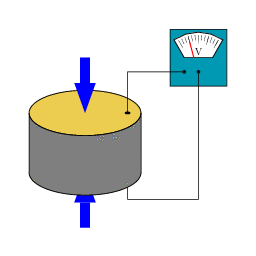
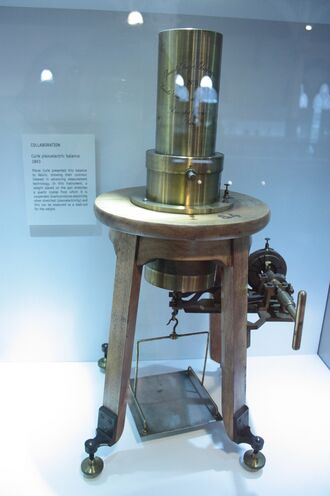
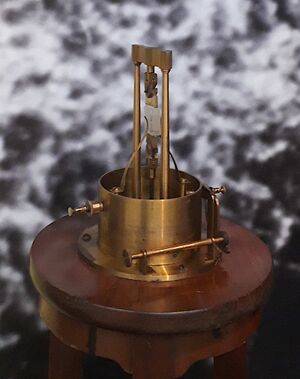









![{\displaystyle {\begin{aligned}\{S\}&=\left[s^{E}\right]\{T\}+[d^{\mathrm {t} }]\{E\}\\\{D\}&=[d]\{T\}+\left[\varepsilon ^{T}\right]\{E\}\,,\end{aligned}}}](https://www.marefa.org/api/rest_v1/media/math/render/svg/0d1f7fbfcf78b67e72bcab8f104ecc09432a1a10)





